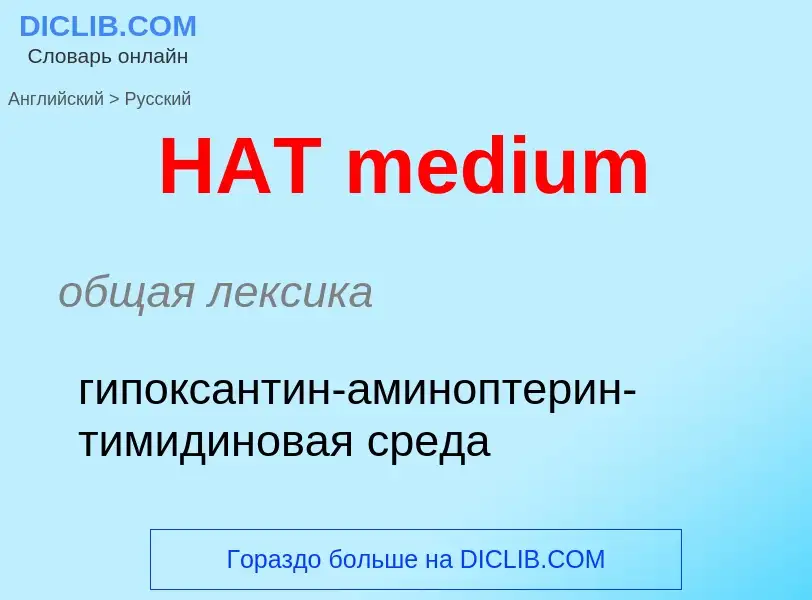Tradução e análise de palavras por inteligência artificial ChatGPT
Nesta página você pode obter uma análise detalhada de uma palavra ou frase, produzida usando a melhor tecnologia de inteligência artificial até o momento:
- como a palavra é usada
- frequência de uso
- é usado com mais frequência na fala oral ou escrita
- opções de tradução de palavras
- exemplos de uso (várias frases com tradução)
- etimologia
HAT medium - tradução para russo
общая лексика
гипоксантин-аминоптерин-тимидиновая среда
ГАТ-среда
общая лексика
селекция (путём выращивания) на среде с гипоксантин-аминоптерин-тимидином
ГАТ-селекция
['ælpain'hæt]
общая лексика
альпийская шляпа
шляпа горца (фетровая шляпа с пером или кисточкой)
Definição
Wikipédia

HAT Medium (hypoxanthine-aminopterin-thymidine medium) is a selection medium for mammalian cell culture, which relies on the combination of aminopterin, a drug that acts as a powerful folate metabolism inhibitor by inhibiting dihydrofolate reductase, with hypoxanthine (a purine derivative) and thymidine (a deoxynucleoside) which are intermediates in DNA synthesis. The trick is that aminopterin blocks DNA de novo synthesis, which is absolutely required for cell division to proceed, but hypoxanthine and thymidine provide cells with the raw material to evade the blockage (the "salvage pathway"), provided that they have the right enzymes, which means having functioning copies of the genes that encode them.
The enzyme dihydrofolate reductase, which produces tetrahydrofolate (THF) by the reduction of dihydrofolate, is specifically blocked by aminopterin. THF, acting in association with specific proteins, can receive single carbon units that are then transferred to specific targets.
One of the important targets for cellular reproduction is thymidylate synthase, which creates thymidine monophosphate (TMP) from deoxyuridine monophosphate (dUMP). By additional phosphorylation reactions, TMP can be used to make thymidine triphosphate (TTP), one of the four nucleotide precursors that are used by DNA polymerases to create DNA. Without the THF required to convert dUMP, there can be no TTP, and DNA synthesis cannot proceed, unless TMP can be produced from another source. The alternative source is the thymidine present in the HAT medium that can be absorbed by the cells and phosphorylated by thymidine kinase (TK) into TMP.
The synthesis of IMP, (precursor to GMP and GTP, and to AMP and ATP) also requires THF, and also can be bypassed. In this case hypoxanthine-guanine phosphoribosyltransferase (HGPRT) reacts hypoxanthine absorbed from the medium with PRPP, liberating pyrophosphate, to produce IMP by a salvage pathway.
Therefore, the use of HAT medium for cell culture is a form of artificial selection for cells containing working TK and HGPRT. Many useful refinements to the scheme are made possible by poisons that kill cells, but to which they are immune if they lack one of these genes. Thus, a cell lacking TK is resistant to bromodeoxyuridine (BrdU) and a cell lacking HGPRT is resistant to 6-thioguanine (6-TG) and 8-azaguanine. Thus, selection with one of the latter two drugs, followed by HAT medium, will yield revertant colonies.



![Abfaltersbach]], E Tyrol; [[Kaltern]], S Tyrol; [[Jenesien]], S Tyrol. (commanders) Abfaltersbach]], E Tyrol; [[Kaltern]], S Tyrol; [[Jenesien]], S Tyrol. (commanders)](https://commons.wikimedia.org/wiki/Special:FilePath/Ssb-LandeskommandantUndBezirksmajore.png?width=200)

![[[Andreas Hofer]], wearing the typical, broad-brimmed flat hat of the South Tyrolean type (posthumous portrait, mid-19th century) [[Andreas Hofer]], wearing the typical, broad-brimmed flat hat of the South Tyrolean type (posthumous portrait, mid-19th century)](https://commons.wikimedia.org/wiki/Special:FilePath/Andreas hofer mit hut.jpg?width=200)
![''Self portrait with Tyrolean hat'' (''Selbstporträt mit Tiroler Hut''), [[Lovis Corinth]] ''Self portrait with Tyrolean hat'' (''Selbstporträt mit Tiroler Hut''), [[Lovis Corinth]]](https://commons.wikimedia.org/wiki/Special:FilePath/Lovis_Corinth_-_Selbstportraet_mit_Tiroler_Hut_1913.jpg?width=200)


